The radar speed displays market is likely to expand from USD 263.6 million in 2025 to USD 371.9 million in 2035, reflecting a CAGR of 3.5%. Compound absolute growth analysis evaluates the cumulative increase in market value over the forecast period, combining the effects of year-on-year growth to highlight total revenue expansion. Between 2025 and 2030, the radar speed displays market is expected to record steady growth, driven primarily by adoption in traffic management, road safety initiatives, and law enforcement projects. Urban infrastructure development and increasing government emphasis on accident prevention contribute significantly to early value accumulation.
From 2030 to 2035, compound growth continues as emerging regions expand road networks and integrate intelligent traffic systems, enhancing demand for radar speed displays. Technological improvements such as solar-powered units, wireless connectivity, and advanced radar accuracy are expected to drive additional adoption in both urban and suburban settings. The absolute value gained over the decade demonstrates a balanced combination of incremental deployment and technological enhancement, reflecting steady, cumulative revenue expansion rather than abrupt surges. The radar speed displays market exhibits predictable compound growth, with continuous adoption, policy-driven demand, and innovation contributing to consistent long-term value accumulation. The analysis underscores a reliable upward trajectory, highlighting opportunities for suppliers and service providers across regions and applications.
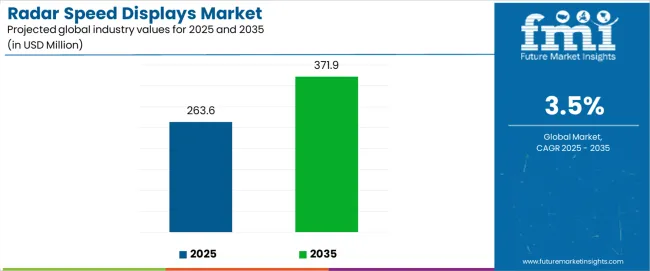
| Period | Primary Revenue Buckets | Share | Notes |
|---|---|---|---|
| Today | Fixed type displays (permanent installations) | 62% | Highway applications, established infrastructure |
| Mobile trailer-mounted systems | 28% | Construction zones, temporary applications | |
| Portable battery-powered units | 10% | Short-term deployments, special events | |
| Future (3-5 yrs) | Advanced fixed systems | 55-58% | Smart connectivity, solar integration |
| Mobile intelligent displays | 22-25% | Enhanced portability, wireless connectivity | |
| Highway applications | 18-22% | Interstate systems, high-speed corridors | |
| City road applications | 15-18% | Municipal streets, school zones | |
| Construction & work zones | 8-12% | Temporary installations, safety applications | |
| Smart city integrations | 6-10% | IoT connectivity, data analytics platforms |
At-a-Glance Metrics
| Metric | Value |
|---|---|
| Market Value (2025) | USD 263.6 million |
| Market Forecast (2035) | USD 371.9 million |
| Growth Rate | 3.5% CAGR |
| Leading Display Type | Fixed Type Systems |
| Primary Application | Highway Segment |
The radar speed displays market demonstrates strong fundamentals with fixed type display systems capturing a dominant share through advanced radar technologies and traffic management optimization. Highway applications drive primary demand, supported by increasing traffic safety requirements and transportation infrastructure modernization initiatives. Geographic expansion remains concentrated in developed markets with established traffic management infrastructure, while emerging economies show accelerating adoption rates driven by urbanization initiatives and rising road safety standards.
Primary Classification: The radar speed displays market segments by display type into fixed, mobile trailer, and others, representing the evolution from permanent installations to sophisticated portable systems for comprehensive traffic speed monitoring optimization.
Secondary Classification: Application segmentation divides the radar speed displays market into highway, city road, and others, reflecting distinct requirements for display visibility, durability standards, and traffic management specifications.
Tertiary Classification: End-use segmentation covers traffic authorities, construction companies, law enforcement agencies, municipal governments, and educational institutions, while distribution channels span direct sales, traffic equipment distributors, and specialized transportation suppliers.
Regional Classification: Geographic distribution covers North America, Latin America, Western Europe, Eastern Europe, East Asia, South Asia Pacific, and Middle East & Africa, with developed markets leading adoption while emerging economies show accelerating growth patterns driven by traffic infrastructure modernization programs.
The segmentation structure reveals display evolution from traditional fixed installations toward sophisticated mobile systems with enhanced connectivity capabilities, while application diversity spans from highway speed enforcement to municipal traffic calming requiring precision monitoring solutions.
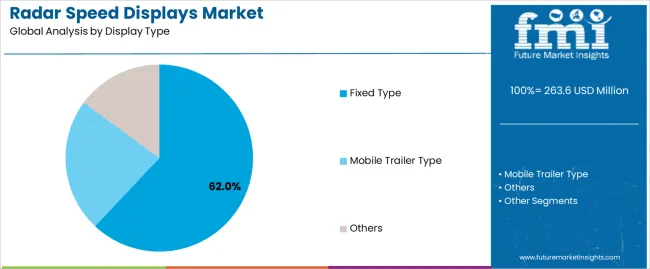
Market Position: Fixed type display systems command the leading position in the radar speed displays market with 62% market share through proven radar technologies, including permanent installation capabilities, high visibility construction, and traffic management optimization that enable transportation authorities to achieve optimal speed monitoring across diverse highway and municipal environments.
Value Drivers: The segment benefits from transportation industry preference for permanent monitoring systems that provide continuous speed detection, professional visibility, and operational reliability without requiring portable infrastructure. Advanced radar processing features enable enhanced accuracy, weather resistance, and integration with existing traffic management programs, where monitoring performance and visibility effectiveness represent critical operational requirements.
Competitive Advantages: Fixed type display systems differentiate through proven installation reliability, permanent monitoring characteristics, and integration with established traffic management systems that enhance infrastructure effectiveness while maintaining optimal safety standards suitable for diverse transportation applications.
Key market characteristics:
Mobile trailer type systems maintain a 28% market position in the radar speed displays market due to their portability advantages and temporary deployment benefits. These systems appeal to facilities requiring flexible monitoring solutions with enhanced mobility profiles for construction zone operations. Market growth is driven by infrastructure development expansion, emphasizing portable traffic solutions and operational efficiency through optimized deployment designs.
Market Context: Highway applications demonstrate strong growth in the radar speed displays market with 36% market share as well as 4.2% CAGR due to widespread adoption of speed monitoring programs and increasing focus on traffic safety excellence, operational cost efficiency, and speed enforcement applications that maximize monitoring effectiveness while maintaining safety standards.
Appeal Factors: Highway operators prioritize display reliability, visibility consistency, and integration with existing traffic infrastructure that enables coordinated speed monitoring across multiple roadway segments. The segment benefits from substantial transportation infrastructure investment and modernization programs that emphasize the acquisition of premium displays for speed enforcement and traffic safety applications.
Growth Drivers: Highway expansion programs incorporate radar displays as essential components for speed monitoring, while interstate development increases demand for display capabilities that comply with federal standards and minimize operational complexity.
Market Challenges: Varying highway requirements and installation complexity may limit display standardization across different routes or traffic scenarios.
Application dynamics include:
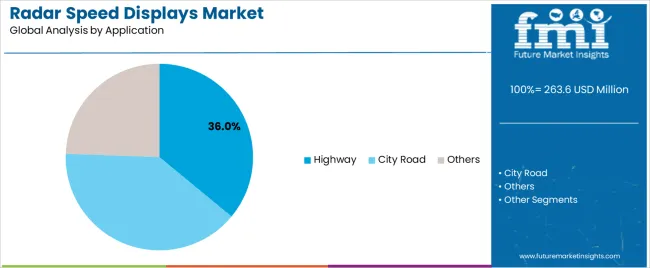
City road applications capture 35% market share through specialized traffic calming requirements in residential areas, school zones, and municipal applications. These facilities demand effective displays capable of supporting speed reduction while providing visibility access and community safety capabilities.
Construction zone applications account for 18% market share, including work zones, temporary installations, and mobile operations requiring portable display capabilities for safety optimization and traffic management effectiveness.
Market Context: Traffic Authorities dominate the radar speed displays market with a 4.0% CAGR, reflecting the primary demand source for radar speed display technology in transportation applications and traffic management standardization.
Business Model Advantages: Traffic Authorities provide direct market demand for standardized display systems, driving volume procurement and cost optimization while maintaining quality control and safety consistency requirements.
Operational Benefits: Traffic Authority applications include safety standardization, cost efficiency, and performance assurance that drive consistent demand for display systems while providing access to latest radar technologies.
| Category | Factor | Impact | Why It Matters |
|---|---|---|---|
| Driver | Traffic safety initiatives & accident reduction (Vision Zero programs, safety campaigns) | ★★★★★ | Growing traffic safety awareness requires effective speed monitoring with enhanced visibility capabilities and enforcement properties proven effective across transportation applications. |
| Driver | Infrastructure modernization & smart city development (IoT integration, data analytics) | ★★★★★ | Transforms traffic management from "basic enforcement" to "intelligent monitoring"; authorities that offer connected displays and analytics features gain competitive advantage. |
| Driver | Urbanization growth & traffic volume increases (population growth, vehicle density) | ★★★★☆ | Urban areas need comprehensive speed monitoring; demand for effective and intelligent display solutions expanding addressable market. |
| Restraint | Budget constraints & procurement limitations (especially for smaller municipalities) | ★★★★☆ | Smaller traffic authorities defer display upgrades; increases price sensitivity and slows advanced technology adoption in cost-conscious markets. |
| Restraint | Alternative traffic calming competition (speed bumps, enforcement cameras) | ★★★☆☆ | Traditional traffic calming methods offer established effectiveness and lower costs, potentially limiting radar display adoption in traditional applications. |
| Trend | Solar power integration & energy efficiency (renewable energy, off-grid capability) | ★★★★★ | Advanced power management, energy optimization, and remote monitoring transform operations; solar integration and efficiency enhancement become core value propositions. |
| Trend | Data analytics & connectivity integration (IoT platforms, traffic insights) | ★★★★☆ | Connected displays for specific traffic patterns and applications; specialized analytics and targeted reporting capabilities drive competition toward intelligent solutions. |
The radar speed displays market demonstrates varied regional dynamics with Growth Leaders including China (4.7% growth rate) and India (4.4% growth rate) driving expansion through infrastructure development initiatives and traffic management modernization.
Steady Performers encompass Germany (4.0% growth rate), Brazil (3.7% growth rate), and developed regions, benefiting from established transportation infrastructure and traffic safety adoption. Mature Markets feature United States (3.3% growth rate), United Kingdom (3.0% growth rate), and Japan (2.6% growth rate), where traffic management advancement and safety standardization requirements support consistent growth patterns.
Regional synthesis reveals Asian markets leading adoption through infrastructure expansion and traffic management development, while North American countries maintain steady expansion supported by display technology advancement and safety standardization requirements. European markets show strong growth driven by traffic safety applications and smart city integration trends.
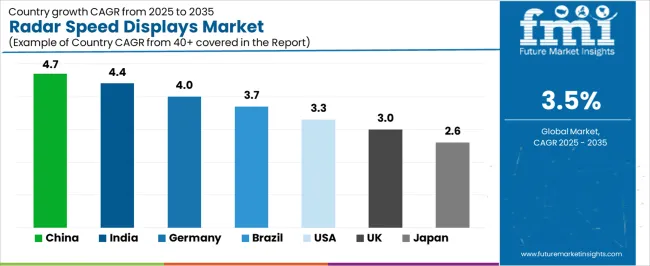
| Region/Country | 2025 to 2035 Growth | How to win | What to watch out |
|---|---|---|---|
| China | 4.7% | Focus on smart city integration solutions | Regulatory changes; local competition |
| India | 4.4% | Lead with cost-effective manufacturing | Import restrictions; infrastructure barriers |
| Germany | 4.0% | Provide premium technology displays | Over-regulation; lengthy approvals |
| Brazil | 3.7% | Offer value-oriented solutions | Currency fluctuations; import duties |
| United States | 3.3% | Push technology integration | Compliance costs; scaling challenges |
| United Kingdom | 3.0% | Focus on premium applications | Economic impacts; procurement costs |
| Japan | 2.6% | Emphasize precision manufacturing | Traditional preferences; adoption rates |
China establishes fastest market growth through aggressive infrastructure development programs and comprehensive traffic management expansion, integrating advanced radar speed display systems as standard components in highway facilities and urban installations. The country's 4.7% growth rate reflects government initiatives promoting transportation infrastructure and domestic traffic technology capabilities that mandate the use of intelligent display systems in highway and municipal facilities. Growth concentrates in major urban centers, including Beijing, Shanghai, and Shenzhen, where smart city development showcases integrated display systems that appeal to traffic authorities seeking comprehensive monitoring optimization capabilities and safety applications.
Chinese manufacturers are developing cost-effective display solutions that combine domestic production advantages with advanced radar features, including enhanced connectivity control and improved visibility capabilities. Distribution channels through transportation suppliers and traffic equipment distributors expand market access, while government support for smart city development supports adoption across diverse highway and municipal segments.
Strategic Market Indicators:
In Mumbai, Delhi, and Bangalore, highway facilities and municipal authorities are implementing radar speed display systems as standard equipment for traffic management and safety optimization applications, driven by increasing government infrastructure investment and urbanization programs that emphasize the importance of traffic monitoring capabilities. The radar speed displays market holds a 4.4% growth rate, supported by government infrastructure initiatives and smart city development programs that promote intelligent display systems for highway and municipal facilities. Indian authorities are adopting display systems that provide consistent speed monitoring and visibility features, particularly appealing in urban regions where traffic safety and congestion management represent critical operational requirements.
Market expansion benefits from growing infrastructure capabilities and international technology partnerships that enable domestic production of traffic monitoring systems for highway and municipal applications. Technology adoption follows patterns established in transportation equipment, where reliability and visibility drive procurement decisions and operational deployment.
Market Intelligence Brief:
Germany's advanced transportation market demonstrates sophisticated radar speed display deployment with documented safety effectiveness in highway applications and municipal facilities through integration with existing traffic systems and transportation infrastructure. The country leverages engineering expertise in traffic technology and intelligent systems integration to maintain a 4.0% growth rate. Transportation centers, including Bavaria, Baden-Württemberg, and North Rhine-Westphalia, showcase premium installations where display systems integrate with comprehensive traffic platforms and infrastructure management systems to optimize speed monitoring and safety effectiveness.
German manufacturers prioritize system quality and EU compliance in display development, creating demand for premium systems with advanced features, including infrastructure integration and intelligent monitoring systems. The radar speed displays market benefits from established transportation infrastructure and a willingness to invest in traffic monitoring technologies that provide long-term operational benefits and compliance with international safety standards.
Market Intelligence Brief:
Brazil's market expansion benefits from diverse infrastructure demand, including highway modernization in São Paulo and Rio de Janeiro, municipal facility upgrades, and government transportation programs that increasingly incorporate radar speed display solutions for traffic applications. The country maintains a 3.7% growth rate, driven by rising urbanization activity and increasing recognition of traffic safety benefits, including precise speed control and enhanced safety effectiveness.
Market dynamics focus on cost-effective display solutions that balance traffic monitoring performance with affordability considerations important to Brazilian transportation authorities. Growing infrastructure development creates continued demand for modern display systems in new highway infrastructure and facility modernization projects.
Strategic Market Considerations:
United States establishes market leadership through comprehensive transportation programs and advanced traffic infrastructure development, integrating radar speed display systems across highway and municipal applications. The country's 3.3% growth rate reflects established transportation industry relationships and mature traffic technology adoption that supports widespread use of intelligent display systems in highway and municipal facilities. Growth concentrates in major transportation centers, including California, Texas, and Florida, where display technology showcases mature deployment that appeals to transportation authorities seeking proven monitoring capabilities and safety efficiency applications.
American transportation providers leverage established distribution networks and comprehensive technical support capabilities, including installation programs and training support that create customer relationships and operational advantages. The radar speed displays market benefits from mature regulatory standards and transportation requirements that mandate display system use while supporting technology advancement and operational optimization.
Market Intelligence Brief:
United Kingdom's transportation market demonstrates integrated radar speed display deployment with documented safety effectiveness in highway applications and municipal facilities through integration with existing traffic systems and transportation infrastructure. The country maintains a 3.0% growth rate, supported by traffic safety programs and monitoring effectiveness requirements that promote intelligent display systems for transportation applications. Highway facilities across England, Scotland, and Wales showcase systematic installations where display systems integrate with comprehensive traffic platforms to optimize speed monitoring and safety outcomes.
UK transportation providers prioritize system reliability and industry compatibility in display procurement, creating demand for validated systems with proven monitoring features, including performance monitoring integration and intelligent safety systems. The radar speed displays market benefits from established transportation infrastructure and safety requirements that support traffic technology adoption and operational effectiveness.
Market Intelligence Brief:
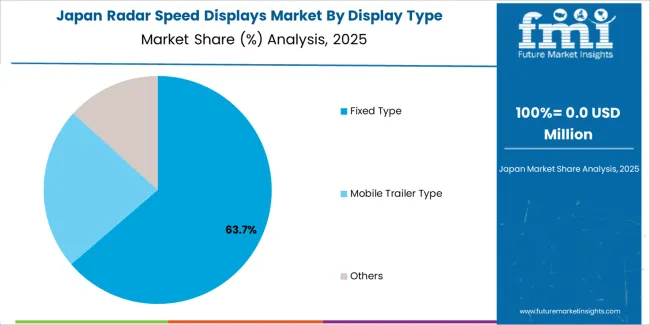
Japan's market growth benefits from precision traffic demand, including advanced highway facilities in Tokyo and Osaka, technology integration, and safety enhancement programs that increasingly incorporate display solutions for monitoring applications. The country maintains a 2.6% growth rate, driven by transportation technology advancement and increasing recognition of precision monitoring benefits, including accurate speed control and enhanced safety outcomes.
Market dynamics focus on high-precision display solutions that meet Japanese quality standards and monitoring effectiveness requirements important to transportation authorities. Advanced traffic technology adoption creates continued demand for sophisticated display systems in highway infrastructure and traffic modernization projects.
Strategic Market Considerations:
The European radar speed displays market is projected to grow from USD 58.4 million in 2025 to USD 82.1 million by 2035, registering a CAGR of 3.5% over the forecast period. Germany is expected to maintain its leadership position with a 42.1% market share in 2025, supported by its advanced transportation infrastructure and major traffic management centers.
United Kingdom follows with a 26.3% share in 2025, driven by comprehensive highway programs and traffic safety development initiatives. France holds a 16.8% share through specialized transportation applications and infrastructure compliance requirements. Italy commands a 9.2% share, while Spain accounts for 5.6% in 2025. The rest of Europe region is anticipated to gain momentum, expanding its collective share from 4.1% to 4.8% by 2035, attributed to increasing traffic safety adoption in Nordic countries and emerging transportation facilities implementing infrastructure modernization programs.
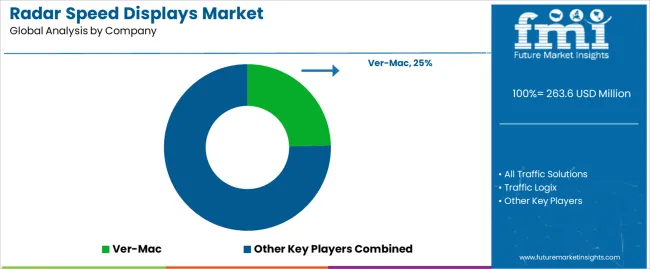
| Stakeholder | What they actually control | Typical strengths | Typical blind spots |
|---|---|---|---|
| Global brands | Distribution reach, broad product catalogs, brand recognition | Wide availability, proven reliability, multi-region support | Product refresh cycles; customer dependency on brand validation |
| Technology innovators | Radar R&D; advanced display technologies; enhanced connectivity properties | Latest technologies first; attractive ROI on monitoring effectiveness | Service density outside core regions; scaling complexity |
| Regional specialists | Local compliance, fast delivery, nearby customer support | "Close to customer" support; pragmatic pricing; local regulations | Technology gaps; talent retention in customer service |
| Full-service providers | Traffic programs, installation services, monitoring management | Lowest operational risk; comprehensive support | Service costs if overpromised; technology obsolescence |
| Niche specialists | Specialized applications, custom displays, connectivity services | Win premium applications; flexible configurations | Scalability limitations; narrow market focus |
| Item | Value |
|---|---|
| Quantitative Units | USD 263.6 million |
| Display Type | Fixed Type, Mobile Trailer Type, Others |
| Application | Highway, City Road, Others |
| End Use | Traffic Authorities, Construction Companies, Law Enforcement Agencies, Municipal Governments, Educational Institutions |
| Regions Covered | North America, Latin America, Western Europe, Eastern Europe, East Asia, South Asia Pacific, Middle East & Africa |
| Countries Covered | China, India, Germany, Brazil, United States, United Kingdom, Japan, Canada, France, Australia, and 25+ additional countries |
| Key Companies Profiled | Ver-Mac, All Traffic Solutions, Traffic Logix, TAPCO, Photonplay Systems, KELIAS, Radarsign, Stalker Radar, Carmanah Technologies |
| Additional Attributes | Dollar sales by display type and application categories, regional adoption trends across East Asia, North America, and Western Europe, competitive landscape with radar manufacturers and traffic equipment suppliers, transportation authority preferences for display effectiveness and traffic monitoring, integration with intelligent transportation systems and traffic management platforms, innovations in radar technology and display enhancement, and development of advanced monitoring solutions with enhanced connectivity and operational optimization capabilities. |
The global radar speed displays market is estimated to be valued at USD 263.6 million in 2025.
The market size for the radar speed displays market is projected to reach USD 371.9 million by 2035.
The radar speed displays market is expected to grow at a 3.5% CAGR between 2025 and 2035.
The key product types in radar speed displays market are fixed type, mobile trailer type and others.
In terms of application, highway segment to command 36.0% share in the radar speed displays market in 2025.






Full Research Suite comprises of:
Market outlook & trends analysis
Interviews & case studies
Strategic recommendations
Vendor profiles & capabilities analysis
5-year forecasts
8 regions and 60+ country-level data splits
Market segment data splits
12 months of continuous data updates
DELIVERED AS:
PDF EXCEL ONLINE
Radar Detectors Market Size and Share Forecast Outlook 2025 to 2035
Radar Security Market Size and Share Forecast Outlook 2025 to 2035
Radar Absorbing Materials Market Size and Share Forecast Outlook 2025 to 2035
Radar & LiDAR Technology for Railways - Trends & Forecast 2025 to 2035
Radar Level Transmitter Market Analysis - Growth & Forecast 2025 to 2035
Radar Market Analysis by Platform, Application, Type, and Region through 2035
60GHz Radar Evaluation Kit Market Size and Share Forecast Outlook 2025 to 2035
X-Band Radar Market Size and Share Forecast Outlook 2025 to 2035
mmWave Radar Module Market Size and Share Forecast Outlook 2025 to 2035
Marine Radar Market Analysis - Size, Share, and Forecast Outlook 2025 to 2035
Surface Radars Market Size and Share Forecast Outlook 2025 to 2035
Vehicle Radar Test System Market Size and Share Forecast Outlook 2025 to 2035
Military Radar Market Size and Share Forecast Outlook 2025 to 2035
Airborne Radar Market Insights – Growth & Forecast 2024-2034
Automotive Radar Sensors Market Size and Share Forecast Outlook 2025 to 2035
Automotive Radar On Chip Technology Market Size and Share Forecast Outlook 2025 to 2035
Automotive Radar Market Growth - Trends & Forecast 2025 to 2035
Off Highway Radar Sensors Market Analysis - Size, Share, and Forecast Outlook 2025 to 2035
Integrated 3D Radar Market Size and Share Forecast Outlook 2025 to 2035
Handheld Police Radar Guns Market Size and Share Forecast Outlook 2025 to 2035

Thank you!
You will receive an email from our Business Development Manager. Please be sure to check your SPAM/JUNK folder too.
Chat With
MaRIA